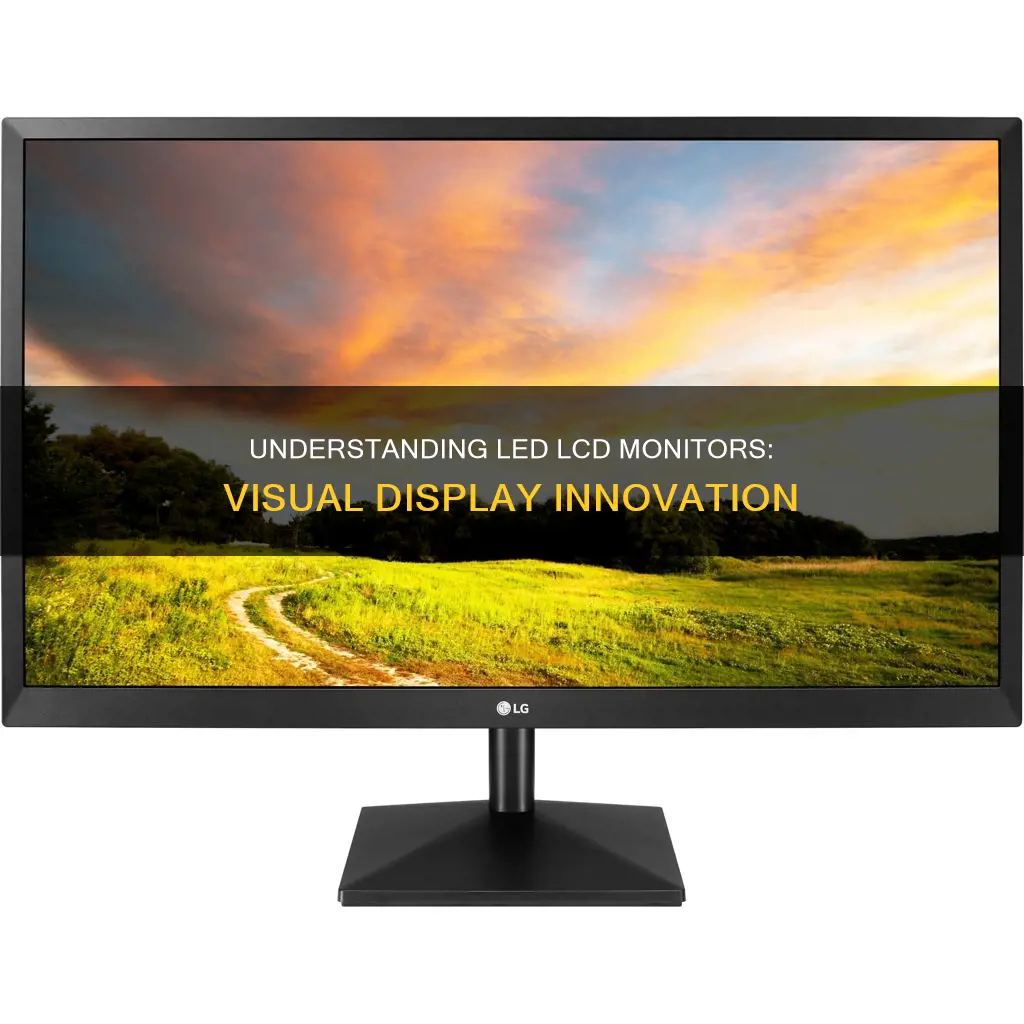
LED (Light-Emitting Diode) and LCD (Liquid Crystal Display) are terms used to describe types of display technology. All LED monitors are a type of LCD monitor, but not all LCDs use LED technology. The difference between the two lies in their backlighting technology. LCD monitors use cold cathode fluorescent lamps (CCFLs) for backlighting, while LED monitors use light-emitting diodes. LED monitors are thinner, lighter, and use less power than LCDs. They also have a longer lifespan and provide sharper and higher-quality images.
| Characteristics | Values |
|---|---|
| Definition | LED is a subset of LCD |
| Backlighting | LED: Light-emitting diodes |
| LCD: Cold cathode fluorescent lamps (CCFLs) | |
| Image Quality | LED: Sharper and higher-quality images |
| LCD: Good image quality | |
| Lifespan | LED: Longer |
| LCD: Average of 50,000 hours | |
| Brightness | LED: Greater nit value, brighter |
| LCD: Average of 500-700 nits | |
| Thickness | LED: Thinner |
| Weight | LED: Lighter |
| Power Consumption | LED: Lower |
| Price | LCD: More affordable |
What You'll Learn

LED monitors use light-emitting diodes for backlighting
LED monitors use light-emitting diodes (LEDs) for backlighting. This is the main difference between LCD and LED monitors. LCD monitors use cold cathode fluorescent lamps (CCFLs) for backlighting.
The term "LED monitor" is shorthand for "LED-backlit LCD monitor". All LED monitors are a type of LCD monitor, but not all LCD monitors use LED technology to illuminate the screen.
LED monitors use two main types of backlighting: full-array backlighting and edge lighting. For edge lighting, LEDs are placed around the edges of the back of the screen. For full-array backlighting, LEDs are placed evenly across the entire screen, allowing for local dimming and better contrast.
LED monitors offer several benefits over CCFL-backlit LCD monitors. They are thinner, lighter, and use less power. LED diodes also last longer than CCFL bulbs. Additionally, LEDs provide superior picture quality with better contrast ratios and deeper blacks compared to LCD displays.
LED monitors are also more energy-efficient than LCD monitors. They require less power to produce the same level of brightness and have better power management features. As a result, LED monitors often lead to lower electricity bills over time.
While LED monitors offer improved performance and energy efficiency, LCD monitors are typically more affordable. Therefore, when deciding between an LCD or LED monitor, it is important to consider your specific needs, budget, and intended use.
Disabling Motion Blur on ASUS Monitors: A Simple Guide
You may want to see also

LCD monitors use cold cathode fluorescent lamps for backlighting
LCD monitors use cold cathode fluorescent lamps (CCFLs) for backlighting. CCFLs are long, thin tubes that produce light through the interaction of electricity with mercury vapour inside the tube. They are known for their long lifespan, high brightness, and low power consumption.
CCFL backlights are widely used in LCD monitors because they can illuminate the entire screen evenly, ensuring clear and vibrant images. CCFL technology offers a bright and even backlighting solution, resulting in sharp images. They have a long lifespan, typically lasting tens of thousands of hours. Additionally, CCFLs consume less power compared to other lighting technologies, making them energy efficient.
However, CCFL backlights have some limitations. They are not ideal for outdoor displays due to their susceptibility to temperature fluctuations and sunlight interference. CCFL backlights are also not well-suited for flexible displays because of their rigid glass tube design.
In recent years, LED backlights have become more common in LCD monitors as they offer advantages in energy efficiency, colour reproduction, and performance. LED backlights are more energy-efficient, have a longer lifespan, and offer better colour accuracy compared to CCFL backlights. They can also be dimmed more effectively, allowing for improved contrast ratios.
While LED technology has become the standard for backlighting, there are still some niche applications where CCFL backlights are used, such as in certain medical devices, industrial equipment, and legacy displays.
Choosing the Right Cord Size for Studio Monitors
You may want to see also

LED monitors have longer lifespans
The longer lifespan of LED monitors is advantageous for several reasons. Firstly, it means that users will not need to replace their monitors as frequently, resulting in cost savings over time. Secondly, LED monitors are more environmentally friendly as they consume less power and produce less waste. Additionally, the longer lifespan can lead to lower maintenance costs and a better overall user experience.
There are several factors that can affect the lifespan of an LED monitor. One of the biggest contributors to diode degradation is heat. As the brightness of a diode increases, it produces more heat, which can shorten its lifespan. The physical environment of the monitor, especially in outdoor settings, can also impact the temperature of the diodes. For example, operating a monitor in a hot climate can cause the diodes to degrade faster.
Other factors that can affect the lifespan of an LED monitor include the quality of the power supply and the other electrical components being powered, such as fans. The architecture and construction of the unit that houses the screen's diodes can also play a role, with good airflow and cooling being important factors in prolonging the lifespan. Additionally, the content displayed on the screen can have an impact, with colours and brightness variations affecting the life of the diode.
While LED monitors have longer lifespans than traditional LCD monitors, there are still ways to maximise their lifespan. Proper care and maintenance, such as regular cleaning and protecting the monitor from moisture and harmful fumes, can help extend its lifespan. Additionally, using a surge protector and avoiding blocking air vents can also help prevent overheating and prolong the monitor's life.
Finding Your VESA Mount Standard: Monitor Size Guide
You may want to see also

LCD monitors are cheaper
The main difference between LCD (Liquid Crystal Display) and LED (Light-Emitting Diode) monitors is their backlighting technology. LCD monitors are typically backlit by cold cathode fluorescent lamps (CCFLs), while LED monitors use light-emitting diodes for backlighting.
LCD monitors are generally cheaper than LED monitors. This is because LCDs have been on the market for a longer period of time and have lower production costs. The price gap between the two has narrowed in recent years as LED technology has become more common and affordable. However, LED monitors still tend to be more expensive due to their incorporation of cutting-edge technologies, such as IPS panels and edge-lit backlights, and their superior energy efficiency.
LCD monitors offer good image quality and are sufficient for traditional computing tasks. They also have some advantages over LED monitors, including:
- Matte screens: Many LCD monitors feature matte screens, which effectively reduce glare in bright environments.
- Consistent lighting: Traditional LCDs often provide more uniform backlighting across the entire screen.
- Less blue light: LCD monitors typically emit less blue light, which can help reduce eye strain.
LCD monitors are a good choice for those on a tight budget, as they offer good value and performance. They are also more widely available in standard shapes and sizes, making them suitable for regular workstations and desktops.
Monitoring Internet Usage: Comcast's Device-Specific Insights
You may want to see also

LED monitors are more energy-efficient
The energy efficiency of LED monitors can lead to lower electricity bills over time. LED monitors also have a longer lifespan compared to LCD monitors, as their backlighting technology is more durable. LED backlights typically last 50,000 to 100,000 hours, while CCFL backlights in LCDs last around 30,000 to 60,000 hours.
In addition to their energy efficiency, LED monitors offer superior picture quality with better contrast ratios and deeper blacks compared to LCD displays. LED monitors also have faster response times, which is important for reducing motion blur and ghosting, especially in gaming and graphic-intensive applications.
LED monitors are also thinner and lighter than LCD monitors, making them a more attractive option for many consumers. However, LED monitors are generally more expensive than LCD monitors, which may be a deciding factor for some buyers.
Overall, LED monitors are a more energy-efficient option than LCD monitors, offering improved performance, longer lifespans, and enhanced image quality.
LCD Monitors in Mercedes: First-Row Experience
You may want to see also
Frequently asked questions
The main difference is in their backlighting technology. LCD monitors use cold cathode fluorescent lamps (CCFLs) for backlighting, while LED monitors use light-emitting diodes.
LED monitors are more suitable for gaming. However, it is recommended to avoid LED screens with edge lighting as they don't allow for any adjustability.
Yes, LED monitors have been proven to significantly reduce eye strain symptoms by providing a wider viewing angle and more adjustability.
LCD stands for Liquid Crystal Display.
LED stands for Light-Emitting Diode.







